| |
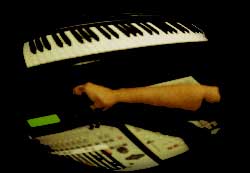



 Here's where we show you how we hook this stuff up. It may not be the "best" way to do it but it seems to work for us.
First, lets understand the different between audio signal flow and midi data signal flow.
Audio signals start with sound sources like keyboards & drum machines. They are then processed (like cheese product) and put onto something like a cassette or CD so you can hear them.
Midi signals start again, at either a keyboard or drum machine & are then recorded on a sequencer. The sequencer then plays back the midi data, basically it plays the keyboard or drum machine back exactly how we enter the notes, thus producing audio signals (sound).It get's real sick real fast. You can get your sequencer going & then sample that,
creating an audio sample or ".wav" file. This wav can then be played back on the machines, of the machines playing themselves. More on this later.
Let's start with the sound sources, since these are the foundation of any electronic studio. The main axes are the Roland XP80 & JP8080 module, and the AKAI
MPC2K sampling drum machine. The YAMAHA O1V is the cheese processor mixing it all down to 2 track.
______________________________
ROLAND
Here's where we show you how we hook this stuff up. It may not be the "best" way to do it but it seems to work for us.
First, lets understand the different between audio signal flow and midi data signal flow.
Audio signals start with sound sources like keyboards & drum machines. They are then processed (like cheese product) and put onto something like a cassette or CD so you can hear them.
Midi signals start again, at either a keyboard or drum machine & are then recorded on a sequencer. The sequencer then plays back the midi data, basically it plays the keyboard or drum machine back exactly how we enter the notes, thus producing audio signals (sound).It get's real sick real fast. You can get your sequencer going & then sample that,
creating an audio sample or ".wav" file. This wav can then be played back on the machines, of the machines playing themselves. More on this later.
Let's start with the sound sources, since these are the foundation of any electronic studio. The main axes are the Roland XP80 & JP8080 module, and the AKAI
MPC2K sampling drum machine. The YAMAHA O1V is the cheese processor mixing it all down to 2 track.
______________________________
ROLAND 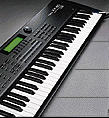 XP80 XP80
The XP80 is a workstation synth, that is, it is designed to play multiple sounds, has effects like echo's & reverb, and it has a sequencer on board, but the sequencer sucks which is why I'm using the Akai. The real strength of the XP80 is it's drum sounds. We've got several of the JV series expansion cards in it which also have a bunch of drums on them.
The XP80 has 4 audio outputs. As good as the drums on the XP80 are, what I usually do is sample the drum sounds and play them from the Akai. This way, we're saving voices on the XP80 for things like the bass line & synth effects. The XP80 has 64 voices, if we played the drums on it internally, we might run out of voices by the time we got around to putting in the finishing touches on a groove.
______________________________
ROLAND  JP8080 JP8080
Slaved to the xp80 via midi the Roland JP8080 analog synth, which makes all those killer analog synth sounds and filter sweeps. The 8080 is basically a much phatter version of "Rebirth" with better sound quality, knobs and sliders to play with, and an awesome apegiator. It also acts as a vocoder to make robot speaking sounds.
______________________________
AKAI 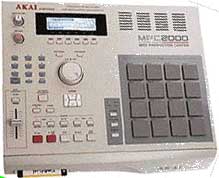 MPC 2000 MPC 2000
Now we get to the brain of the rig at this point in time. The Akai MPC 2000 sampling drum machine. This is the sequencer that drives the other sound sources. The Akai has a 64 track midi sequencer on board and it holds audio samples for playback like drum sounds & other stuff. I have a major love/hate thing going with this machine. On the one hand I love it's feel, on the other I hate it's operating system. You can read more about that here.
The Akai, with the audio output expansion option, has 10 audio outputs, so we can send the kick, snare, and other parts of a pattern to different inputs on the sound board for individual processing. More about this later. The Akai is both receiving midi data (in record mode) and playing back midi data and internal samples (in play & record modes). The problem we're running into among other things is the difficulty in working with "loops" within the akai.
It's editing capabilities suck, you're way better off using "Cool Edit" or some other software on the PC to tweak samples. We're probably going to start using a combination of "Cakewalk" and "Acid" to work with loop based compositions. Then dump them back to the Akai for live performance. The net result is that I'll be making loops with the Akai and the synths, sampling them into Acid, writing with them, and then digitally dumping the material back to the Akai, since we've no interest in taking a PC out to gigs. Sounds like fun doesn't it?
______________________________
YAMAHA 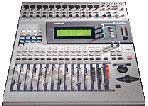 O1V. O1V.
The next piece is the sound board. This is where the sound sources are mixed together for final processing. We're using the Yamaha O1V digital sound board. This amazing piece of modern technology simply must be seen to be believed! It acts like a regular mixing board but it's programmable. It also has real onboard effects & dynamics processing which are also fully programmable.
It has 4 band full parametric EQ's on all inputs & all outputs. It simply rocks. Probably the neatest thing about this board is the automation capabilities. You can play a song & record the boards movements on a midi track of the sequencer. When you play it back you can have things like moving faders and effects turning on & off right on cue, right where you recorded them.
The O1V is in my opinion the best piece of gear to come out in a couple of years and I highly recommend it to anyone doing this sort of music, or any small to mid size band out playing gigs. It costs about $1,500. It's worth twice that.
______________________________
This may all seem a bit complicated, and, if you're new to Midi systems & keyboards it is, but, once you have a basic understanding of the intricacies of both signal flow & midi routing you can basically start writing songs. Sure, there's more to it.
This will be up very soon!
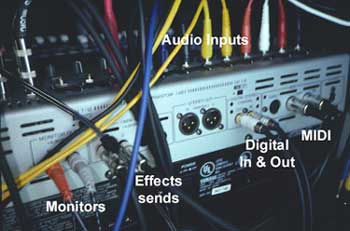
|

|
 |







 XP80
XP80 JP8080
JP8080 MPC 2000
MPC 2000 O1V.
O1V.